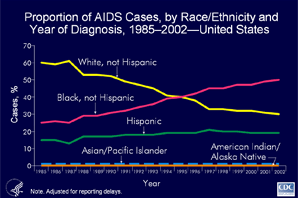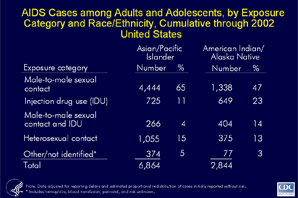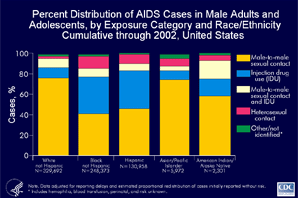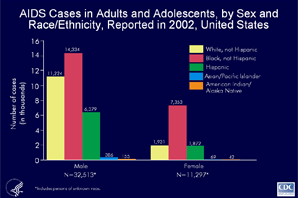|
|
|
|
|
|
||
|
Divisions of HIV/AIDS Prevention |
|||||||
| Slide Sets | Home | Index | Search | Site Map | Subscribe | Contact Us |
HIV/AIDS Surveillance by Race/Ethnicity
L238 slide series
(through 2002)
Download complete set (10 slides) in PDF format (Adobe Acrobat v5.0 or higher) - (184 KB)
Download complete set (10 slides) in PPT format (PowerPoint 2002 required) - (788 KB)
While the content is in the
public domain and no copyright
restriction applies,
we do ask that users preserve the slides in their current
format and cite CDC as the source.
See "Instructions for Downloading and
Using HIV/AIDS surveillance slides".
Adobe Acrobat (TM) Reader v5.0 or higher needs to be installed
on your computer
in order to be able to read the slides in Adobe PDF (Portable Document Format).
Download the Adobe
Acrobat (TM) Reader
 |
 |
| Slide 1 AIDS Cases in Racial/Ethnic Minorities by Year, 1985 - 2002, United States |
Slide 2 Proportion of AIDS Cases, by Race/Ethnicity and Year of Diagnosis, 1985 - 2002 - United States |
| Zoom/Download Slide 1 | Zoom/Download Slide 2 |
 |
 |
| Slide 3 AIDS in Blacks |
Slide 4 AIDS in Hispanics |
| Zoom/Download Slide 3 | Zoom/Download Slide 4 |
 |
 |
| Slide 5 AIDS Cases among Adults and Adolescents, by Exposure Category and Race/Ethnicity, Cumulative through 2002 United States |
Slide 6 AIDS Cases among Adults and Adolescents, by Exposure Category and Race/Ethnicity, Cumulative through 2002 United States |
| Zoom/Download Slide 5 | Zoom/Download Slide 6 |
 |
 |
| Slide 7 Proportion of AIDS Cases and Population, by Race/Ethnicity 2002, United States |
Slide 8 Percent Distribution of AIDS Cases among Male Adults and Adolescents, by Exposure Category and Race/Ethnicity Cumulative through 2002—United States |
| Zoom/Download Slide 7 | Zoom/Download Slide 8 |
 |
 |
| Slide 9 Percent Distribution of AIDS Cases in Female Adults and Adolescents, by Exposure Category and Race/Ethnicity Cumulative through 2002—United States |
Slide 10 AIDS Cases in Adults and Adolescents, by Sex and Race/Ethnicity, Reported in 2002 United States |
| Zoom/Download Slide 9 | Zoom/Download Slide 10 |
